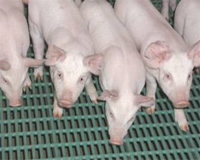Persistent resistance on antibiotic-free farms

Bacteria taken from farms still showed resistance, up to 2 ½ years after the administering of antibiotics was discontinued, a Canadian study says. Farms quitting antibiotics may still be breeding grounds for drug-resistant germs, reported Science magazine.
Ecologist Martin Chénier and his colleagues of McGill University, Canada, wanted to know whether drug resistant bacteria would, when their exposure to antibiotics ceased, throw out the genes that code for antibiotic resistance.
The study was performed on gut bacterial populations of ten pigs taken from the McGill University Swine Complex farm that had banned all antibiotics in 2007.
After the pigs were slaughtered, the researchers grew the microbes in the lab.
Between 70%-100% of the bacteria were still resistant to chlortetracycline, and while resistance genes are generally easy to shed, Chénier thinks that the genes for chlortetracycline resistance are linked to other genes vital to protecting the pig from metal toxicity.
The use of swine waste as fertilizer may be spreading the antibiotic resistance further afield, with bacteria potentially sharing their resistance with bacteria crops and in the drainage system.
The study highlights the indirect consequences of antibiotic use, the link between farmyard resistance and clinical resistance has yet to be found.
When scientists follow the bacteria through the meat production process, they find the meat to be safe.
The risk assessment guidelines set up for pig processing appear to be successful in keeping the gut bacteria from contaminating the meat and the facilities.
And while the knock-on effects are unknown, it is clear that the bacteria on farms are preserving their resistance and persevering. The team will publish their work in Microbial Ecology next year.











